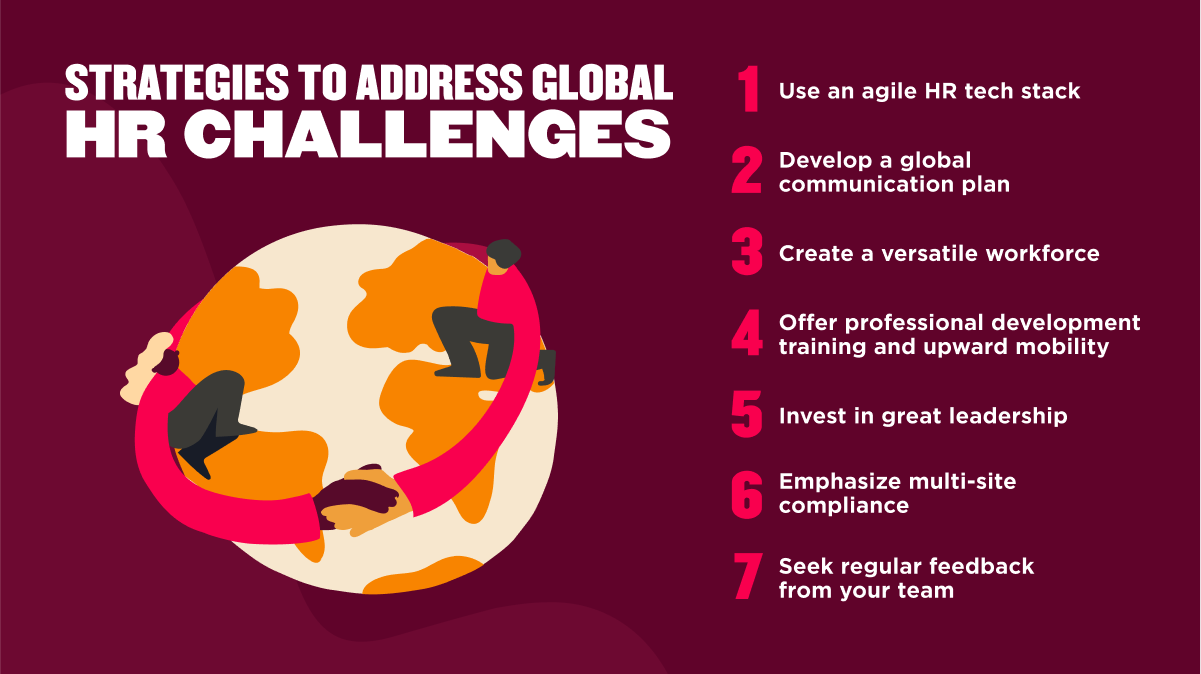Today’s multi-national HR teams face increasingly complex global HR challenges. From return-to-office (RTO) strategies to the adoption or continuation of remote and hybrid work models, there has been a true reshaping of business operations and workforce management.
While this also brings about a wide range of benefits, such as a cultured workforce, international expansion, and the ability to hire from diverse global talent pools, it also brings about a spectrum of constantly changing HR issues. These international HR challenges require nuanced and proactive approaches.
Organizations today must comply with local laws and regulations, encourage cohesive company cultures across borders, and meet evolving workforce expectations. All of this while facing mounting global challenges, including widespread inflation, recessions, and geopolitical conflicts.
It would be fair to say that HR teams across the world have quite a bit on their plate. With this in mind, let’s take a look at some common issues HR professionals at global companies face and how to overcome them.
<<Download a free HR strategy workbook to streamline global HR planning.>>
Why global companies face unique HR challenges
Managing HR on a global scale brings an entirely different set of considerations compared to local operations. While local HR teams may focus on standard policies, region-specific compliance, and internal culture building, global HR professionals must juggle all that—and more—across diverse regions, legal systems, and cultural contexts. From coordinating teams in different time zones to staying on top of evolving international regulations, the complexity quickly multiplies.
Global HR is not just about scale; it’s about nuance. What works in one country may not translate to another, and seemingly simple tasks like payroll processing or performance reviews can become significantly more complex when operating across borders. This calls for tailored strategies that acknowledge the unique needs of each location while maintaining organizational cohesion and alignment.
Top international HR challenges for multi-national teams
From navigating legal regulations to encouraging collaboration across cultures, these global HR challenges highlight the intricacies of multi-national HR management.
1. Remote hiring and onboarding
Hiring people worldwide results in a more diverse workforce and a wider talent pool to choose from. However, many companies don’t have human resources management professionals working at each of their global sites. This means they have to recruit and onboard new hires remotely.
Not being able to meet a candidate face-to-face is a challenge in itself. Hiring and onboarding processes across borders often take much longer than local processes because HR needs to verify that all references, credentials, and educational qualifications are sound. It’s also equally important to ensure that every new joiner—whether they’re onsite, hybrid, or remote—gets the same great onboarding experience and that the onboarding program they receive is tailored to their specific location.
And of course, there’s a high cost associated with making the wrong hire or not onboarding a team member properly. That’s why vetting all prospects carefully before hiring them and making sure they are properly onboarded is crucial.
<<Use this free remote onboarding checklist to simplify multi-national hiring.>>
2. Logistics of internationally dispersed teams
Navigating the complexities of an internationally dispersed team can be tricky. From mixing cultures to balancing time zones, it’s certainly no easy task to get everything right. Here are some of the most common logistical challenges facing globally dispersed teams and how you can fix them:
- Scheduling across time zones. When one part of your team’s morning is another part of your team’s night, scheduling can be a headache. The main challenge is finding common working hours that are convenient for team members in different parts of the world. Utilizing tools such as shared calendars and time zone converters can help you schedule meetings at times that align respectfully and conveniently with people’s working hours.
- Communication and coordination. With different working hours, communication can be an issue. That’s why embracing asynchronous communication is crucial for global teams. It allows people in different time zones to contribute to important issues without feeling pressured to respond immediately. For it to work, it’s important to set up robust communication platforms and set clear expectations (and boundaries) around response times.
- Ensuring C-suite representation in all regions. When executives are concentrated in one region, it’s easy for other areas to feel disconnected. To ensure leadership representation across regions, prioritize hiring executives from diverse geographic areas and establish regional leadership roles. Regularly rotate leadership meetings across different locations to include varied perspectives, and create advisory boards or committees with representatives from all regions to provide input on high-level strategies. This approach ensures that leadership decisions reflect the needs and insights of every location.
3. Multi-national compliance with local employment laws
Global companies with offices worldwide need to ensure they comply with local laws and regulations. While it’s up to HR to guarantee every site remains compliant while also ensuring they’re taking a people-forward approach, having an in-house lawyer or legal team specializing in international labor law is also good business practice for multi-national compliance.
For example, payroll compliance, while intricate, is an opportunity to ensure fairness by aligning with local tax codes and understanding region-specific benefits. Companies can achieve this by investing in reliable payroll software tailored to local requirements and regularly updating it to reflect changes in legislation.
But payroll is just one piece of the puzzle. Broader employment laws—covering areas like hiring, termination, and relocation—also vary significantly by country (and even by state in the United States). These regulations govern key aspects of the professional lifecycle, including employment agreements, notice and termination procedures, immigration and work permits for relocating people, and tax and social security laws. Partnering with local experts, such as legal advisors or HR consultants, can provide valuable insights and help address complex multi-national compliance challenges. Staying informed, implementing effective tools, and encouraging collaboration will help organizations maintain compliance confidently while creating a positive and equitable experience for all team members.
<<Download a free HR compliance checklist to support effective multi-national compliance.>>

4. Fair and ethical policies across borders
Creating fair and ethical policies is the cornerstone of building trust amongst global teams. Regular check-ins, transparent communication, and accountability measures help create an environment where people feel respected and valued.
Global teams also face challenges related to compensation strategies and privacy. Ensuring equitable pay across regions and taking into account cost-of-living disparities builds confidence in your organization’s fairness.
Similarly, safeguarding personal data in compliance with regulations like the European Union’s General Data Protection Regulation (GDPR) demonstrates a commitment to ethical practices. This not only builds trust with stakeholders but also reinforces an organization’s dedication to transparency and accountability.
5. International talent development and training
Cultural differences, time zone disparities, and accommodating diverse employee learning preferences can impact the effectiveness of global training initiatives.
To overcome these challenges, HR teams can implement virtual solutions that provide scalable and inclusive learning and development programs tailored to global audiences. Using a cloud-based learning management system (LMS) can improve accessibility and efficiency across diverse teams.
Focus on providing clear growth opportunities by developing skill-building workshops and leadership development programs that align with both local needs and overarching global objectives. Regularly gather and assess feedback from your people to ensure these initiatives support individual professional growth while driving meaningful organizational results.
6. Retention
In the current economically challenging and low-budget climate, retaining talent is more vital than ever. In order to do this, it’s crucial for companies to understand what their people want and what they need.
One of the most effective ways to retain talent is by committing to a culture of honesty and trust. Being open with your people about the state of the business and their individual potential and future with the company is critical. Providing your people with competitive compensation and benefits packages also goes a long way when it comes to successfully attracting and retaining top talent worldwide. Additionally, including flexible working arrangements, career development programs, and a people-focused company culture in your offering can help boost retention.
<<Use a free employee retention plan template to optimize multi-national retention efforts.>>
7. Sharing knowledge across borders
Knowledge sharing refers to the process of sharing information. Sharing knowledge—whether between individuals, departments, or organizations—increases motivation and productivity, enabling people to work faster with access to the resources and insights they need.
For companies with multiple offices worldwide, this process can be a challenge. Succeeding depends on a company’s commitment to prioritizing knowledge sharing. Embed it into your culture and weave it into your company values. Consider emphasizing its importance to team members from their first day to help it become a daily habit.
Communications tech is essential for quality knowledge sharing. Choosing a platform that integrates with the company’s existing tech stack is a must for enabling automated knowledge transfer and providing your people with the information they need while leveraging the tools your company already uses.
It’s up to HR to ensure that the company has an efficient, centralized platform for storing and sharing knowledge that all team members can access—no matter where they are in the world.
8. Maintaining a healthy, global work environment
It can be difficult to create a sense of unity when people have never met face-to-face, but it’s an essential part of creating an effective team. Frequently communicating with all team members and scheduling regular meetings, such as all-hands meetings, team meetings, and one-on-ones, will help keep physically distant teams connected and create a sense of belonging.
Virtual team-building games, ice-breaking sessions, and group celebrations for shared holidays or team achievements can be great bridge-builders for dispersed teams. These small, intentional moments contribute to a more human-centered culture, even across time zones.
It’s important to recognize the value of remote work etiquette, including being mindful of time zones, using inclusive language, and clearly showing availability. Encouraging professionals to keep their calendars updated, respect focus hours, and communicate proactively can go a long way in creating a smooth and respectful workflow.
Equally important is supporting team members’ wellbeing. Offering access to mental health resources, wellness programs, and opportunities to disconnect after hours helps professionals stay energized and engaged. When teams feel supported both professionally and personally, it becomes easier to foster trust, collaboration, and long-term commitment—no matter where they’re located.
9. Cultural differences
Cultural awareness is not optional for global teams—it is a critical component of success. To collaborate effectively, team members must navigate language barriers, adapt to diverse communication styles, and approach differences with respect, which is the cornerstone of productive and harmonious teamwork.
To build cultural awareness and safety, organizations can implement targeted training programs that educate people about the nuances of different cultures. These programs should include practical exercises, such as role-playing scenarios, to help team members practice empathy and adaptability.
Embracing diversity, equity, inclusion, and belonging (DEI&B) in the workplace goes hand in hand with respecting other cultures, and HR teams play a pivotal role in driving these initiatives. They can organize culture-focused discussions, such as workshops or panel talks, to deepen people’s knowledge of global perspectives. Providing resources like cultural guides or communication tips tailored to specific regions can further equip teams to navigate cross-cultural interactions with confidence.
10. Geopolitical conflicts
With the sad reality of multiple wars around the globe, communications, supply chains, and even workplace harmony have been disrupted and destabilized. As HR leaders, it’s important to understand how to handle delicate situations and avoid heated arguments in the workplace. In order to be as prepared as possible, create an HR strategy that can address how to handle sociopolitics in a work setting. With this in hand, you can help find a balance between respectful discourse and overly heated discussions that are inappropriate for a place of work.
<<Use this free HR strategy checklist to create an effective HR plan.>>
11. Implementing global HR software
Bringing HR technology to life across multiple countries is an exciting opportunity, but it also calls for thoughtful planning to ensure every team member, no matter where they are, feels included and supported. From language preferences to varying levels of digital access, it’s important to meet professionals where they are. Here are a few ways to ensure your global rollout is smooth, accessible, and engaging for everyone:
- Prioritize accessibility by ensuring the platform works across devices, internet speeds, and regional tech standards—making it easy for every team member to log in, connect, and engage
- Support multiple languages so people can navigate the platform comfortably and confidently in the language they use day-to-day
- Offer responsive, regionally aware support, with help resources and service hours that reflect local time zones and cultural norms
- Adapt for local needs by incorporating jurisdiction-specific compliance requirements, local holidays, and culturally relevant features that make the experience feel familiar and relevant
- Deliver inclusive training experiences, using localized onboarding, in-language resources, and user-friendly walkthroughs to help everyone get started with ease
When implemented with care, global HR software can become the heartbeat of a company—fostering transparency, celebrating milestones, and helping people feel connected across borders. With the right tools and strategy in place, your platform can support a thriving culture, no matter where your teams are based.
<<Questions and checklists: Buyer’s guide for HRIS! Get the guide.>>
Strategies to address global HR challenges

New, people-centric and global HR strategies are the key to staying ahead of the competition and helping businesses thrive—especially in the face of the changing expectations of the global workforce.
Effective high-level strategies designed to take on issues in international HRMs include:
1. Use an agile HR tech stack
Having an agile HR tech stack in place ensures business continuity and that your people can communicate and collaborate effectively across time zones and distances. Your stack can include communications tech like Zoom, Teams, Slack, email, a project management system, payroll software—and a global human resources information system (HRIS) or similar HR platform to save time, automate repetitive HR processes, and drive retention with tailored experiences for your people worldwide.
A human capital management solution (HCM) such as Bob provides one centralized platform to manage all core HR processes across the organization, such as compensation and performance management.
It also provides a single source of truth for your team members across sites, with all people data in one place. Bob is a fully customizable HR platform that supports multiple languages, including US, Australian, and UK English; French; French Canadian; German; Swedish; Italian; Norwegian; Danish; Spanish (LATAM); Chinese (Mandarin); Dutch (NL); Portuguese (Brazil); Polish, Turkish, and Finnish. It can be localized per site to align with local time zones, date and clock formats, holiday calendars, and currencies.
2. Develop a global communication plan
Developing a global communication plan helps you determine what you want to say to people across your organization, clarifies when you’ll communicate with them, and defines what technology you’ll use. It helps you be consistent and coordinated with your communications to achieve your goals.
Arranging one-on-one meetings and providing people with frequent feedback about your global communication plan helps HR professionals create and support a solid and cohesive company culture across all sites.
3. Create a versatile workforce
You may already have a wealth of untapped skills in your existing workforce. Simple communication with your people can be the key to discovering talents and experiences your business may need but hasn’t put to use, allowing you to integrate them into your workforce planning. Consider bringing contractors and freelancers on board to help carry the workload, shift quickly to new projects, and adjust to today’s fast-evolving business landscape.
This flexibility is a vital part of modern workforce planning, allowing your company to scale up or shift focus without the need for long-term commitments.
4. Offer professional development training and upward mobility
Investing in the upskilling and reskilling of talented team members is not only an efficient and effective way to add even more value to your global workforce but also facilitates upward mobility—providing your teams with the confidence of long-term job stability and further opportunities for growth. This forward-thinking approach helps showcase that you’re committed to their professional development, which in turn leads to more engaged and future-ready teams.
5. Invest in great leadership
Effective company leadership on a global scale requires training in management and prioritization skills so international teams can function smoothly across time zones and distances. Leaders who can help their team members work through cultural differences and expectations, time zone issues, and conflict resolution can help your organization stay ahead of the competition.
Ensuring your company leadership knows how to communicate effectively with their international teams, from C-levels to line managers, and is fully trained in multi-cultural communication and etiquette, puts your company in a solid position to take on any global HR challenges that arise.
6. Emphasize multi-site compliance
When companies expand globally, it’s important to navigate the politics, policies, and laws that exist in the places where they operate. A good way to go about this is by hiring in-house legal advisors to ensure local and worldwide compliance as your organization grows. When your organization is undergoing global expansion, you can tailor your HR programs to address your now multi-national organization’s ever-growing, ever-changing legal and cultural requirements.
Any effective global HR management strategy requires companies to take a comprehensive approach. This includes developing and implementing a global communication plan, building a versatile workforce, and ensuring compliance with international and local laws. It can also include upskilling and reskilling your talented team members and investing in leadership training—showcasing your commitment to their professional development.
7. Seek regular feedback from your team
Feedback helps your global HR team understand what’s working and what isn’t. Collecting input from the global team helps you identify potential problems and make improvements before they escalate.
You can use surveys, polls, or one-on-one meetings to gather feedback. Surveys provide broad insights, while one-on-one conversations allow for more in-depth discussions. Regularly reviewing this feedback helps keep your HR policies relevant and effective.
When people see that their opinions are valued and acted upon, it builds trust and encourages open communication. This ongoing dialogue strengthens your global HR strategy and ensures it evolves to meet the needs of your team.
Support your multi-national team with effective HR management
At the end of the day, it’s down to HR managers to address international human resources management (IHRM) challenges and create an effective HR strategy. This strategy should prioritize global collaboration and unity, support a coherent global company culture, and maintain seamless communication between multiple sites.
A modern HR platform that supports international and remote teams is the perfect tool to help HR managers manage their processes and people more efficiently. With a helping hand from HR tech, HR leaders can better focus on putting their people front and center and creating a culture where everyone feels like they truly belong.
<<Explore the best global HR software for your multi-national company.>>
FAQs on international HR challenges
What is one major HR challenge in international business?
While there are many advantages to global business models, they also introduce added complexity—especially when it comes to managing people across borders. Navigating different time zones, aligning workplace cultures, and ensuring compliance with varying regulations all require flexibility and foresight. However, these challenges also offer a chance to build more resilient, inclusive practices that support growth and innovation across the organization.
Managing compliance with diverse labor laws across multiple regions can be a complex aspect of international business, but it also presents an opportunity to build a stronger, more adaptable organization. Each country—and sometimes even specific regions within countries—has unique regulations around taxes, benefits, working hours, and employment contracts.
For instance, European countries often prioritize robust labor protections, while in the United States, regulations can vary significantly from state to state. This encourages global HR teams to stay proactive, collaborate with legal experts, and design policies that respect local laws while ensuring consistency across the company.
Recommended For Further Reading
- HR strategy & business alignment workbook
- 11 challenges with Gen Z: Workplace strategies to maximize Zoomers’ potential
- A time of change: How modern HR tech solves HR’s biggest challenges
- Hiring? Here are 2025’s big recruiting challenges
- HR job titles: A complete list for the new world of work
- HR strategy presentation template
What is a global HR strategy?
A global HR strategy is a roadmap for managing people across multiple locations. It focuses on supporting a diverse workforce while aligning with the company’s goals and values. This type of strategy balances local practices with global consistency. It includes everything from hiring and onboarding to compliance, training, and employee engagement.
A successful global HR strategy doesn’t stop at logistics or legalities—it also builds a cohesive company culture. It creates a framework to ensure every team member, whether they work in an office in New York or remotely from Tokyo, feels supported and connected. It’s about bridging cultural and geographical gaps and facilitating collaboration across borders.
Why is global HR important?
Global HR plays a key role in helping multi-national companies operate smoothly and grow. Companies that focus on global HR can build stronger cultures that respect and celebrate diversity. It ensures compliance with local laws, reduces operational risks, and encourages collaboration across regions. Ultimately, this allows businesses to focus on what matters most: empowering their people to do their best work, no matter where they are.


